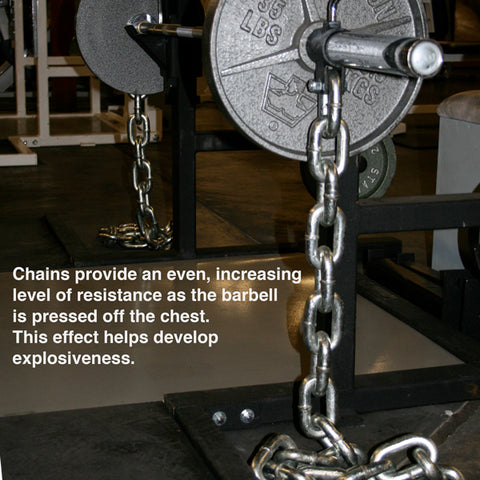Bench Press Breakthrough!

Tools to Help You Bench More
A closer look at chains, bands, and the BFS Bench Block
The bench press is a BFS core lift that is unparalleled for developing strength in the triceps, chest, and shoulders. It has become such an important part of any athlete’s training that the most common question asked to those who lift weights is, “How much can you bench?”
In the early days of the Iron Game, bodybuilders often trained the bench press with low reps and heavyweights. The result is that many of them became especially strong. Reg Park, who won his first Mr. Universe title in 1951 and who appeared in five Italian-made Hercules movies, was the first bodybuilder to bench press 500 pounds. Arnold Schwarzenegger said that Park was his role model. Despite Arnold’s long arms that gave him poor leverage for the lift he was also able to bench 500 pounds.
The first powerlifter to bench press 600 pounds was Pat Casey, who retired after officially bench pressing 615 pounds in 1967. Then came James Williams.
When Williams was 12 years old he could bench press 200 pounds, and he lived up to his potential. His competition lifts were performed with a two-second pause on the chest and were performed in a “raw” fashion, as supportive equipment was not available in his day. In the 1972 World Championships, he made his official best with 675 pounds, missing 700. That record held for 22 years. To put that lift into perspective, consider that the current “raw” bench press world record is 722 pounds, made by Eric Spoto in 2013. As for the absolute record using supportive gear, that record belongs to Ryan Kennelly who did 1075 in 2008. In the women’s division, April Mathis established the world raw record in 2014 with 440 pounds, and Becca Swanson holds the absolute record using supportive gear with the best of 600 pounds that she made in 2008.
One reason the absolute and overall standards for bench press are so high now is because of superior training methods, including chains and bands. These tools work because the bench press has an ascending strength curve, such that you can display more strength as your arms straighten. As such, this part of the lift does not receive sufficient overload as the initial drive off the chest.

Lifting Chains provide an even, increasing level of resistance as the barbell is pressed off the chest; this enables the resistance curve of the exercise to match more closely an individual’s strength curve. However, because the resistance increases as the arms straighten during the press, the body attempts to increase muscle tension at the beginning of the lift to complete the lift. This effect develops explosiveness. The most efficient type of chains are designed such that the chains attached to a collar that attaches to the barbell, which is the type that BFS sells. However, regular collars should still be used to safely secure the plates on the bar.
Lifting Bands provide the most resistance at the end range of the lift, such that the athlete can apply more force during this portion of the lift. The effects of bands on strength were explored in a study published in 2006 in the Journal of Strength and Conditioning Research. The authors concluded that when used in conjunction with free weights, bands improved peak force and peak power more than free weight training without bands.
Another way to use bands is to attach them to the top of a power rack – most BFS racks have power racks with attachments for bands at both the bottom and the top of the racks. Because the bands reduce the resistance at the start of the lift, bands used in his manner would have the same effect as chains in teaching the athlete to accelerate the weight off the chest.
The challenge with bands is that they are not as stable as free weights or chains, and as such require some practice to master – an alert, trained, spotter is a must. That’s why it’s best to perform band bench presses inside a power rack with the safety bars adjusted to the appropriate height – this set-up will help prevent injury should the athlete lose control. Also, it’s important to check the bands regularly for damage or excessive wear to ensure they will not tear apart during use.
The BFS Towel Bench
An additional method to overload the end range of motion of a bench press is to perform bench presses through a partial range of motion. One way to do this, which BFS has been promoting for nearly four decades, is to place a rolled-up towel or round piece of foam under the shirt to restrict the range of motion. By limiting the range of motion of the exercise, you can overload the strongest position of the exercise. Foam bench pads a good, but now BFS offers Bench Blocks, which are better. BFS Bench Blocks solid pieces of rubber that attach to the bar and thus effectively reduce the range of motion. Bench Blocks are much more efficient than using a towel or towel bench pad, especially when several athletes are training on the lift at one station.
One of the criticisms of the bench press is that it places high levels of stress on the connective tissues of the shoulder, especially if performed several times a week. By limiting the range of motion of the lift with a BFS Bench Block, the stress is minimized. As such, the lift can be performed more frequently. In the BFS off-season program, one common workout design is to perform the conventional bench press on Monday and the bench press with the BFS Bench Block on Friday. The lift can also be performed heavy in-season, even the day before a competition because this bench variation places less stress on recovery ability.
There is no substitute for getting strong with the bench press, but using tools such as chains, bands, and BFS Bench Blocks can accelerate your progress to the next level. So how much can you bench?
